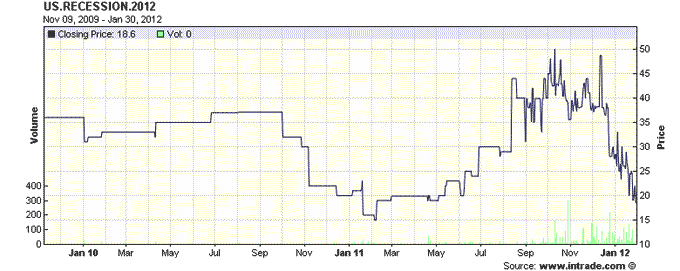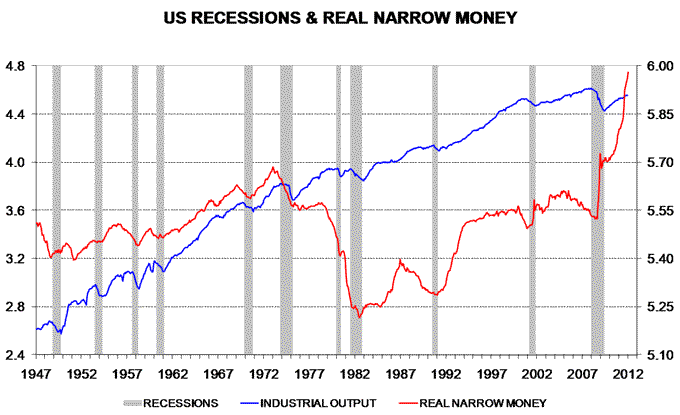Is the US recession scare over?
US recession fears have dissipated in response to stronger-than-expected economic news in recent months. The expectation here remains that the economy will grow respectably during 2012 but the data flow may turn more mixed near term, triggering renewed recession worries.
Fears reached a peak last autumn soon after a 30 September recession call by the highly-regarded Economic Cycle Research Institute (ECRI). The Intrade prediction market 2012 US recession contract topped at $5.0 on 10 October, implying a 50% probability of two consecutive quarterly GDP declines – see first chart. (The contract pays out $10 if the latter condition is met in 2012 and zero otherwise.)
A post in early October argued that a recession would be highly unusual against a backdrop of rapid real money expansion. 10 out of 11 post-war US downturns were preceded by a contraction of the real narrow money supply – second chart. The exception was the 1953-54 recession, apparently caused by severe fiscal tightening as defence spending was slashed after the Korean war.
The monetarist view seemed to receive support in late 2011 as economic news surprised positively, contributing to a fall in the Intrade contract. The implied probability rebounded towards 50% in mid December after the ECRI reaffirmed its recession call but has since collapsed to below 20% – first chart. (The contract closed last week at $1.86.)
Economic news, however, could turn less favourable near term, reviving recession nerves. Activity is likely to have been artificially boosted in late 2011 by businesses bringing forward spending on capital goods (including autos) ahead of a reduction in the bonus depreciation allowance from 100% to 50% – this boost should turn to a drag in early 2012. A rise in stocks last quarter increases the risk that any demand set-back will be reflected in lower production.
In addition, some analysts argue that seasonal adjustments to economic data were unduly favourable in late 2011, with the effect likely to unwind during the first half of 2012. Adjustment algorithms, it is claimed, have been distorted by a collapse in activity in late 2008 / early 2009, part of which is being wrongly assigned to normal seasonal variation, with the pattern extrapolated to later years.
Monetarist analysis continues to suggest a low probability of a recession but is less clear-cut than last autumn. Real narrow money is still expanding and has been the best single monetary indicator of downturns. Real broad money, however, has slowed while the real monetary base has fallen since July – third chart.




Reader Comments